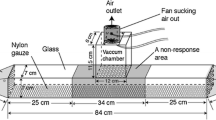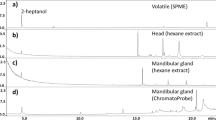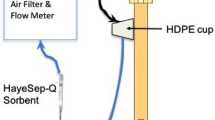Abstract
Twelve compounds identified from honeybee,Apis mellifera L., sting extracts were evaluated in a standardized laboratory test for their effectiveness in eliciting an alarm response from caged worker honeybees. Two-1-decanol and phenol-were judged ineffective as alarm pheromones. The other ten-1-butanol, isopentyl acetate, isopentyl alcohol, 1-hexanol, 2-heptyl acetate, 2-heptanol, 1-octanol, 1-acetoxy-2-octene, 2-nonyl acetate, and 1-acetoxy-2-nonene-produced alarm responses of similar speed and intensity. Three non-sting-derived compounds-β-ionone, methyl benzoate, andtrans-cinnamaldehyde—caused weak or no responses, indicating that the responses were not simply a reaction to concentrated odoriferous substances.
Similar content being viewed by others
References
Blum, M.S., Fales, H.M., Tucker, K.W., andCollins, A.M. 1978. Chemistry of the sting apparatus of the worker honeybee.J. Apic. Res. 17(4):218–221.
Blum, M.S.,Fales, H.M.,Tucker, K.W.,Collins, A.M., andHoward, R. Unpublished data.
Boch, R., andShearer, D.A. 1966. Iso-pentyl acetate in stings of honeybees of different ages.J. Apic. Res. 5(2):65–70.
Boch, R., Shearer, D.A., andStone, B.C. 1962. Identification of isoamyl acetate as an active component in the sting pheromone of the honeybee.Nature 195:1018–1020.
Collins, A.M. 1980. Effect of age on the response to alarm pheromones by caged honeybees.Ann. Entomol. Soc. Am. 73:307–309.
Collins, A.M., andBlum, M.S. 1982. Bioassay of compounds derived from the honeybee sting.J. Chem. Ecol. 8(2):463–470.
Collins, A.M., andRothenbuhler, W.C. 1978. Laboratory test of the response to an alarm chemical, isopentyl acetate, byApis mellifera.Ann. Entomol. Soc. Am. 71(6):906–909.
Hollander, M., andWolfe, D.A. 1973. Nonparametric Statistical Methods, pp. 191–192. John Wiley & Sons, New York.
Kulinčević, J.M., andRothenbuhler, W.C. 1973. Laboratory and field measurements of hoarding behavior in the honeybee.J. Apic. Res. 12(3):179–182.
Shearer, D.A., andBoch, R. 1965. 2-Heptanone in the mandibular gland secretion of the honey-bee.Nature 206:530.
Woodrow, A.W., Green, N., Tucker, H., Schonhorst, M.H., andHamilton, K.C. 1965. Evaluation of chemicals as honeybee attractants and repellents.J. Econ. Entomol. 58(6):1094–1102.
Author information
Authors and Affiliations
Additional information
In cooperation with Louisiana Agricultural Experiment Station.
Mention of a trademark, proprietary product or vendor does not constitute a guarantee or warranty ot the product by the U.S. Department of Agriculture and does not imply its approval to the exclusion of other products or vendors that may also be suitable.
Rights and permissions
About this article
Cite this article
Collins, A.M., Blum, M.S. Alarm responses caused by newly identified compounds derived from the honeybee sting. J Chem Ecol 9, 57–65 (1983). https://doi.org/10.1007/BF00987770
Received:
Revised:
Issue Date:
DOI: https://doi.org/10.1007/BF00987770




